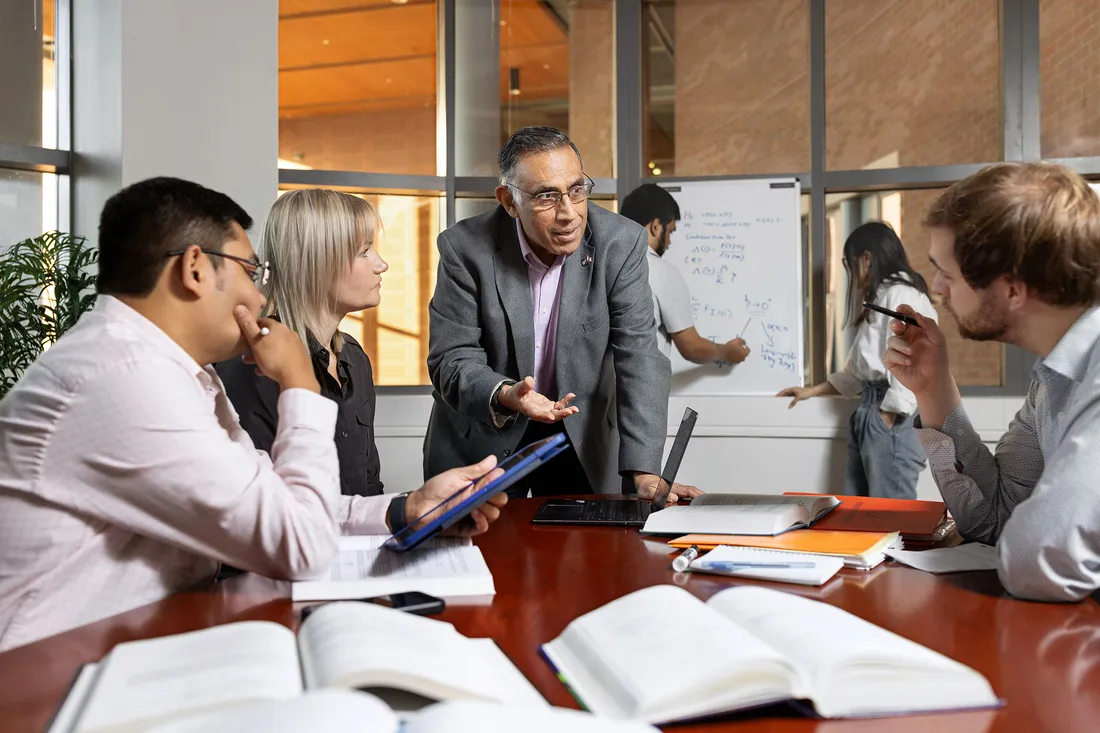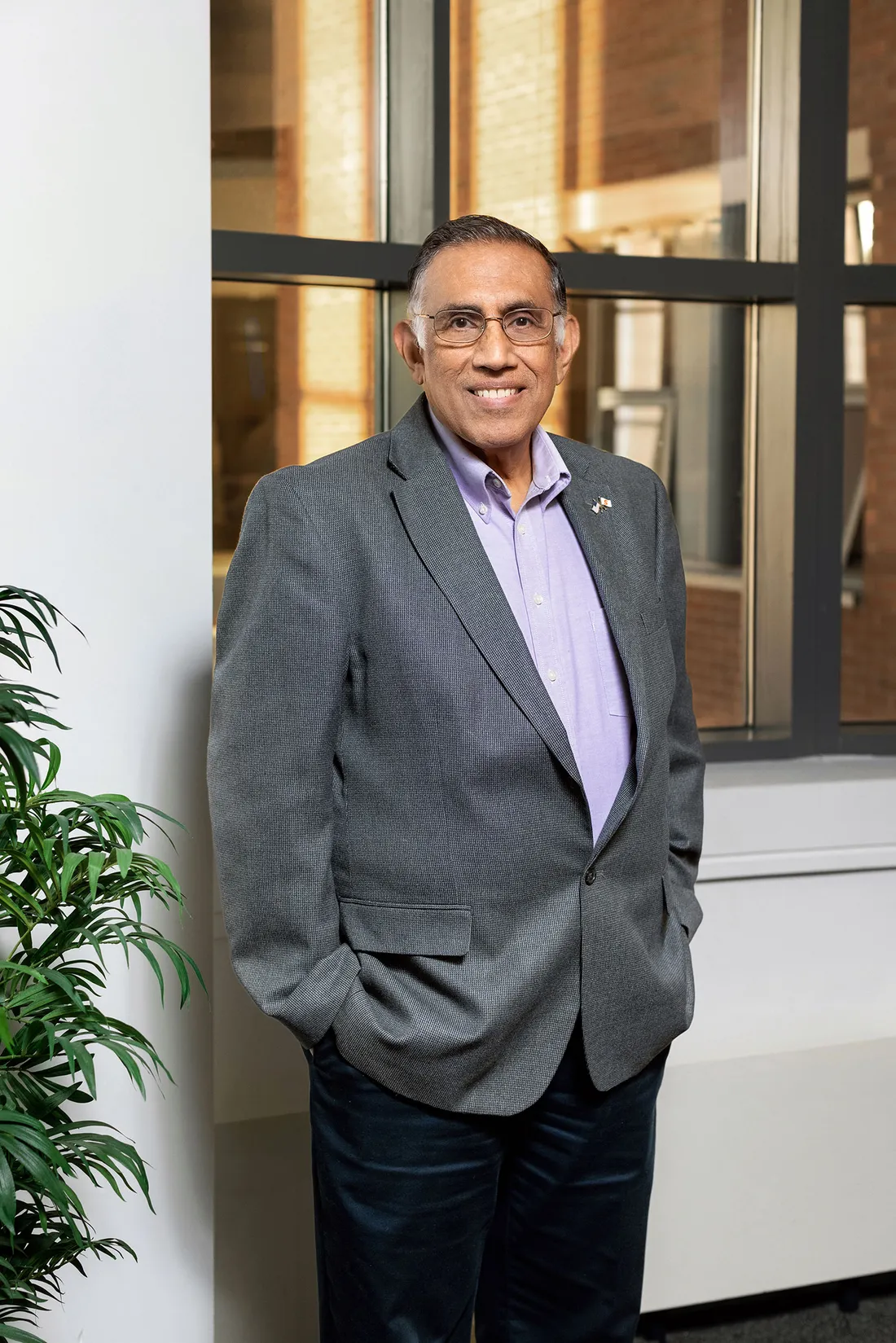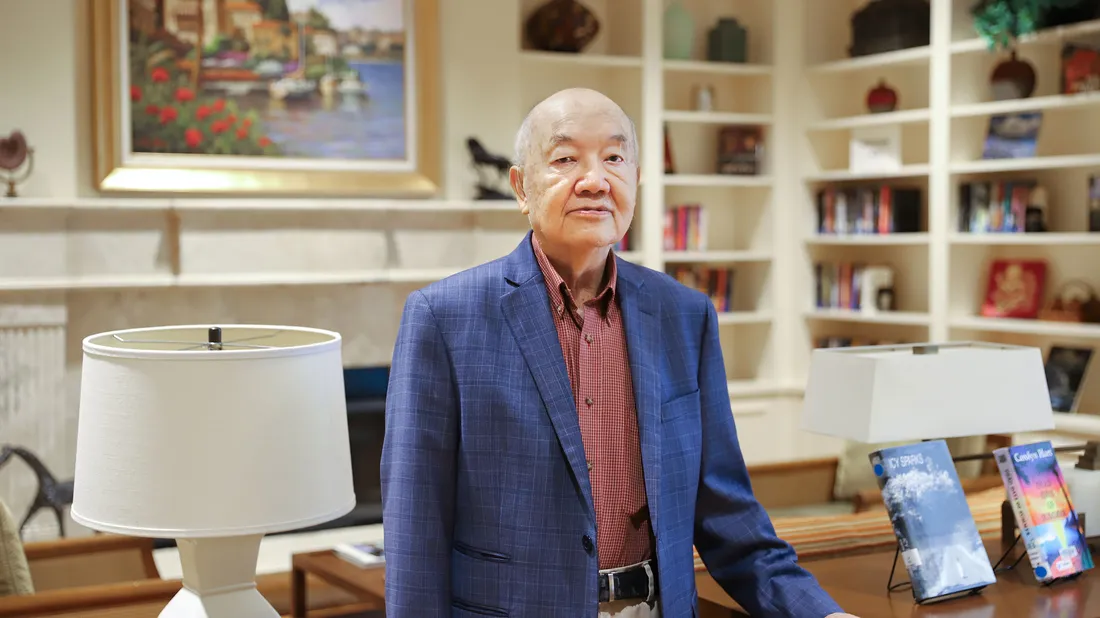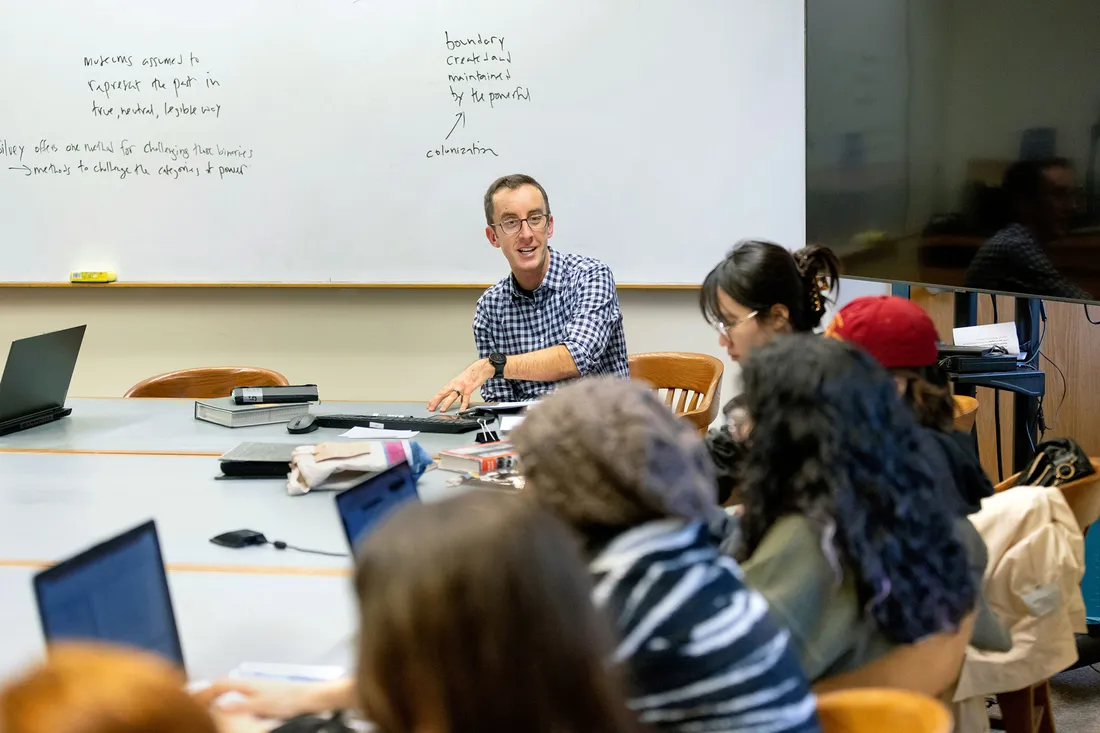
Pramod Varshney (center), Distinguished Professor of Electrical Engineering and Computer Science, is a pioneer of data/information fusion.
Professor Pramod Varshney remembers the day he found his calling. “It was a Thursday,” says the data fusion pioneer, “and I was attending an IEEE [Institute of Electrical and Electronics Engineers] symposium in Santa Monica, California. A program manager from the Department of Defense was giving a plenary talk about the limitations of radar systems that help aircraft approach and land.”
The year was 1981, and Varshney was a relatively new faculty member at Syracuse University. The problem wasn’t with the radars, he recalls, but with the lack of system optimization. “Radars need to be able to talk to one another and a common place—to what we call a data fusion center,” Varshney continues. “This kind of information sharing is critical, especially when a pilot encounters a troublesome situation.”
The February symposium was timely, as more than a hundred people died that month in aviation accidents around the world. “Good data-sharing systems might have prevented these tragedies,” says the Distinguished Professor of Electrical Engineering and Computer Science in the College of Engineering and Computer Science (ECS).
Varshney is revered for his contributions to statistical signal processing, enabling us to see things in data not possible via direct observation. His forte is a field called data/information fusion. “Data” refers to raw facts, like those obtained from sensors (e.g., radars). “Information” is the result of processing and refining this data, providing the basis for drawing inferences and taking actions.
He’s built a career on combining data and information from multiple sources—humans, sensors and databases—that lead to real-time, comprehensive assessments of situations and phenomena.
“We’ve only scratched the surface of what data/information fusion can do,” says Varshney, who also is affiliated with the University’s Center for Advanced Systems and Engineering (CASE). “It has the power to make meaningful, real-world impact.”
Data/information fusion has the power to make meaningful, real-world impact.
Pramod Varshney, Distinguished Professor of Electrical Engineering and Computer Science
Healing Through Data
Varshney’s work is rooted in math: calculus, differential equations, linear algebra, probability and statistics. He also recognizes the importance of emerging machine learning models and algorithms, necessitated by the vast amount of data generated by currently deployed sensors.
Applications of his research are found in industries as wide-ranging as health care and the life sciences, banking and finance, government and defense, and energy and utilities.
For example, Varshney has collaborated with radiologists from SUNY Upstate Medical University to advance the field of medical imaging using a technique called image fusion.
Medical imaging modalities include computed tomography (CT), positron emission tomography (PET) and X-rays. Image fusion merges information from these modalities into a single 3D image of incomparable depth and precision.
“Image fusion helps with early detection and treatment. It’s a lifesaver for patients suffering from dreaded diseases like cancer,” he says.
Fusing Theory and Practice
Varshney arrived at Syracuse in 1976, after earning three degrees, including a Ph.D. in electrical engineering, from the University of Illinois Urbana-Champaign in six years.
In those days, data/information fusion was practically left field. “Actually, there was no field at all,” he counters. “If I may say so, I got the ball rolling.”

Applications of Varshney’s work are found in health care and the life sciences, banking and finance, government and defense, and energy and utilities. “We’ve only scratched the surface of what data/information fusion can do,” he says.
Fast forward almost 50 years, and Varshney’s name has become synonymous with data/information fusion. In 2022, his work supported a different kind of fusion—nuclear fusion ignition, which was demonstrated by Varshney’s collaborators at Lawrence Livermore National Laboratory in California. This process, which powers the sun and stars, is paving the way for advancements in the future of clean power, he says.
Varshney is equally proud of his affiliation with CASE, which he led from 2009-23. Working with high-tech clients, he advises them on matters of early-stage innovation and new ventures strategy. His students, in turn, put their education to work, devising algorithms based on data from different sources, like radar, acoustic wave, radio frequency and camera sensors.
He’s recently teamed up with CASE-affiliated companies to improve airport passenger screening, airspace monitoring and drone tracking. “CASE is a living laboratory, where we find technology to commercialize and then bring it to market,” says Varshney, under whose leadership the center’s economic impact approached $400 million.
Fellow ECS professor Chilukuri Mohan marvels at how Varshney uses his extensive knowledge and experience to foster student and faculty success.
“He’s mentored several faculty members and advised nearly 70 Ph.D. students who now hold leadership and faculty positions around the world,” Mohan observes. “Along with his late wife, Anju G’86, G’90, Professor Varshney has gone to great lengths to treat advisees like family members and ensure their well-being.”
Being a Force for Good
Varshney remains as curious as ever, a self-avowed lifelong learner. He has the numbers to prove it. Four patents. Seven books. Hundreds of papers, grants and contracts.
ECS Dean J. Cole Smith considers him a consummate scholar. “His excellent technical depth and compelling real-world applications across a host of contexts bring outstanding visibility to the college and our department,” he says.

Varshney works with students in the Center for Advanced Systems and Engineering (CASE), which advises high-tech clients in early-stage innovation and new ventures strategy. Under his leadership, CASE’s economic impact approached $400 million.
Biao Chen, the John E. and Patricia A. Breyer Professor of Electrical Engineering, agrees, noting Varshney’s contributions to the theory and practice of complex information systems.
“He’s also laid the groundwork for distributed detection theory, which has influenced research into wireless sensor networks and sparked applications in emerging fields like the Internet of Things,” Chen says.
In 2022, Varshney was twice-recognized by IEEE with the Aerospace and Electronic Systems Society Pioneer Award and the Shannon-Nyquist Technical Achievement Award. “I believe in using technology to improve global conditions,” proclaims Varshney, also an IEEE Fellow and Judith A. Resnik Award winner.
Other honors include a Chancellor’s Citation for Excellence—Lifetime Achievement Award from Syracuse and an honorary doctorate from Drexel University.
Whether developing signal processing methods to track Alzheimer’s disease, deep learning techniques to improve the accuracy of breast cancer screenings, or acoustic and seismic ground sensors for security and surveillance, Varshney insists on being a force for good.
When asked what’s next, he respectfully pauses and smiles. “I don’t know, but it’s going to be fun finding out.”
Professor Varshney’s technical depth and real-world applications bring outstanding visibility to the college.
J. Cole Smith, Dean of the College of Engineering and Computer Science


